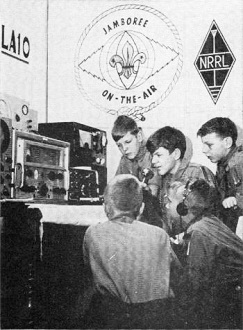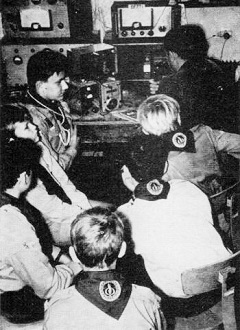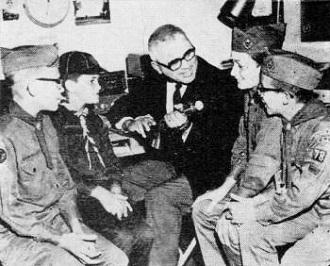Scouting and the Radio Amateur |
|
  demonstrating proficiency at defined tasks.
Radio proficiency is one such merit badge. In order to earn the Radio merit badge,
along with certain other projects the Boy Scout must participate in either Amateur
Radio, Broadcast Radio, or Shortwave Listening. This article reports on amateur
radio activities across the globe. The Scout oath is, "On my honor I will do my
best To do my duty to God and my country and to obey the Scout Law; To help other
people at all times; To keep myself physically strong, mentally awake, and morally
straight." demonstrating proficiency at defined tasks.
Radio proficiency is one such merit badge. In order to earn the Radio merit badge,
along with certain other projects the Boy Scout must participate in either Amateur
Radio, Broadcast Radio, or Shortwave Listening. This article reports on amateur
radio activities across the globe. The Scout oath is, "On my honor I will do my
best To do my duty to God and my country and to obey the Scout Law; To help other
people at all times; To keep myself physically strong, mentally awake, and morally
straight."Scouting and the Radio Amateur Jamboree-on-The-Air The Year Round?By Edward A. Gribi, Jr., * WB6IZF FCC Chairman Rosel H. Hyde has recently said "Statistics seem to suggest ... some lack of interest in the amateur service by our youngsters ... (This situation) ... does require our earnest attention" (QST, April, 1967, p. 61). O.K., so we need to keep the younger fellows coming along to keep amateur radio progressing. How do we go about approaching these youngsters and whetting their interest? One of the best ready-made avenues is via the Scouting movement - with over four million active boys in the U. S. between 8 and 18. The radio amateur should look on Scouting as one of the several areas in which he may implement the "service" aspect of the amateur service. Certainly one of our purposes is to create enough interest on the part of boys so that some may become amateurs. However, we can't expect all boys to be equally motivated. Simply by exposing boys to amateurs and amateur operation we will be molding their image of amateurs as "cool heads" instead of "those nuts that wreck TV." And certainly the amateur has many capabilities that can be of vital aid to the Scouting program. Some of these areas where we've helped in the past include providing communications for various Scouting events and training boys in code and electronics. Besides expanding these services future possibilities might include help in the formation of Scouting nets to let Scouts and Scouters get to know each other better. The Jamboree-On-The-Air event is doing that already but it only happens once a year. Perhaps our goal should be Jamboree-On-The-Air year round. Let's take a look at specific aspects of possible amateur radio service to Scouting. Cub Scouts - These 8- to 11-year olds are full of fun and enthusiasm. They're organized into small Dens with a Den Mother; and a group of Dens makes a Pack led by a Cubmaster. Their three ranks, Wolf, Bear, and Lion, are gained by accomplishing a series of achievements and electives. Under electives are such things as "Make and use a crystal set" and "Make and operate a radio using one or more tubes." Lots of opportunity here to dig through your junk box to help a boy make a radio. A Den Mother would probably love to have you invite her Den to your shack even if they do no more than talk to another Den across town on two meters. Remember, though, that whether Den Mother, Scoutmaster, or Council Scout Executive you may find the person has little idea of what amateur radio may do for them. You may have to use some low pressure salesmanship with persistence. Boy Scouts - Boys 11 through 17 may become Boy Scouts by joining a Troop and passing the Tenderfoot tests. Patrols, run by boy leaders, comprise a troop with the adult Scoutmaster in overall charge. Advancement through set requirements gains Second Class and First Class rank while set requirements plus elective merit badges gain the Star, Life, and much coveted Eagle rank. Emphasis in the early stages is on outdoor achievements but in the higher ranks the sky's the limit! (The Space Exploration merit badge was recently introduced.) The First Class Scout, among other things, is required to "send and receive at least 20 words, using either international Morse or semaphore codes and necessary procedure signals." There are merit badges on Atomic Energy, Communications, Electricity, Electronics, Radio, and Signaling, to name those where an amateur might most likely help. Of the seven requirements for the Radio merit badge, a current amateur license is a substitute for the code requirement of 5 words a minute. Amateurs are always welcome in Troops to help boys with the First Class code requirements and to act as merit badge counselors. The station at Circle 13 Scout Ranch in the Kern River headquarters is the only communication for this remote California camp. Last summer it proved its worth relaying messages to anxious parents in the Los Angeles area when a bus break-down prevented several units from leaving the camp for home until a day behind schedule. Perhaps you can't take several weeks off during the summer, but how about providing your mobile or portable set-up at a Camporee or for a weekend at a Scout camp? Explorers - A boy going into high school and reaching age 14 may then join an Explorer Post. Emphasis in Exploring is on boy organized and conducted activities with a boy-elected President and other leaders, with adults participating as Advisors and consultants. Posts are classified as "general interest" or "special interest," with special interests ranging from aviation to zoology. The two types of Posts overlap activities in that they all attempt to provide experience for these teenagers in social, vocational, outdoor, personal fitness service and citizenship areas. Several Explorer Posts have amateur radio as a specialty and quite a few have specialties in electronics and other scientific fields. Post 1, King City, California, has amateur radio as a specialty and its activities may be more or less typical of a meshing of amateur and Scouting fields. Half of the members are licensed, mostly Technicians. Club station license, WB6SBL, is held and the Post owns equipment for capabilities from 80 through 2. Post members have participated in SET exercises, Jamboree-On-The-Air, a local fair, have visited Oscar headquarters and electronics manufacturers, and have used amateur gear on several activities including 55-mile backpack hikes and beach trips. Activities for the immediate future include providing communications at a District Camporee and at a Council-wide Explorer Road Rally over a hundred mile course. While amateur activities are included only insofar as members' interests dictate, all members have been exposed. Scouts of the U.S.A., visiting the Johnston Historical Museum at the National Headquarters in New Brunswick, N. J., spoke to brother Scouts in 17 countries and 43 of the United States, over K2BFW, the Hq. station of the Boy's life Radio Club. Trustee of K2BFW is W2GND, shown interviewing Scouts. K2BFW had over 1500 c.w. and phone QSOs during the JOTA weekend. Sea Exploring - This branch used to be known as "Sea Scouting" but it is now the division of Exploring that is involved in boating, seamanship, and other marine activities. Little has been done in the past by amateurs in this field, but it requires little imagination to envision the services amateur radio could perform. Jamboree-On-The-Air - This event was organized 10 years ago out of the thought that amateur radio might provide a vehicle for Scout to Scout communication for that vast majority of Scouts who will never have an opportunity to participate in the great National or World Jamborees. Of course, in the process it will expose many youngsters to amateur radio as an avocation and a service and to the general field of electronics. The Ninth Jamboree, October 22-23, 1966, was a great success in spite of its coinciding with a major DX contest. More than 3000 stations were known to have participated from 67 different countries. U. S. participation, heretofore modest, showed a fantastic tenfold jump over prior years with at least 1500 stations participating, Through the layers of QRM, U.S. stations succeeded in having many successful QSOs with other U. S. and Canadian stations and an occasional DX "catch." Participants will long remember the beautiful evening round table on the high end of 40 when Scouts from the east coast were talking with brother Scouts in Canada, the Midwest, and the far west. 1967 is the 60th anniversary of the Scouting movement and it will be commemorated as the 12th World Jamboree convenes August 1-9 at Farragut, Idaho. The World Jamboree will have its own station, K7WSJ, operative during the entire period. Jamboree-On-The-Air will be the weekend of August 5th and 6th. As before, the basic purpose of J.O.T.A. will be to provide a medium for Scouts to talk to other Scouts wherever they may be. If you're interested in serving Scouting, this event is a "must." Make your plans now to have one or more local units at your shack sometime during that period. Or arrange to take your mobile rig in to your Council's Scout Camp and string some dipoles from pine trees. The Boy Scouts World Bureau report on 1966 J.O.T.A. suggests that the aim of the 1967, J.O.T.A. should be "A WORLD-WIDE NETWORK OF SCOUT STATIONS IN 1967." Is this aim too ambitious for amateurs and Scouts and Scouters to accomplish? * Advisor, Explorer Post 1, King City, California 93930.
Posted November 1, 2021 |
|



